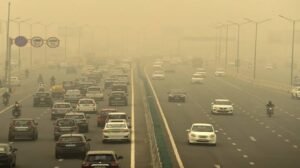With the air pollution in Delhi-NCR dipping alarmingly, authorities have now upped stringent measures under the Graded Response Action Plan (GRAP) Stage III in a bid to tackle the situation. It is a sad truth that air quality in the region has risen to alarming levels. Forcing a series of steps to deal with the situation by cutting down pollutants in the air. Including the commencement of junior schools online, restrictions on certain vehicles, and stopping construction activities that cause dust and emissions. Here’s everything in detail about the measures in place and their implications. And what one can expect from Delhi-NCR residents in the coming days.
Air Pollution: Current State of Air Quality in Delhi-NCR
Delhi’s air quality has stayed in the “severe” category for two consecutive days, data furnished by the Commission for Air Quality Management (CAQM) shows. The 24-hour average AQI (Air Quality Index) was at 424 on Thursday, indicating dangerously high pollutant concentrations. At this point, the GRAP Stage III has come into effect. And the entire Delhi and its surrounding areas have been brought under several restrictions to check pollution and safeguard public health.
Air Pollution: GRAP III Implemented
1. Transitioning Online Classes to Primary Schools
To reduce the children’s exposure to severe air pollution, all classes from the school-going students up to Class V would be conducted online in all schools, whether government or private schools, in the Delhi NCR region. This order will take effect from 8 am tomorrow morning. As per the officials, it is expected to reduce the immediate health effects of the poor quality of air on the little children, who are more sensitive to breathing problems.
2. Suspension of Certain Construction and Demolition Activities
GRAP III halts the constrictions and demolitions that cause dust generation and, therefore, air pollution instantly. Works of public importance concerning metro construction, railway works, and all other linear works such as highways, roads, and flyovers. Which do not involve a direct risk of causing dust pollution, are exempted from this ban. Construction without a power supply in winter may help curb dust pollution, which is one major source of pollution during winter.
3. Air Pollution: Delhi-NCR Vehicle Curbs
Restrictions on Older Vehicles: GRAP III prohibits the plying of BS III petroleum and BS IV diesel-run four-wheelers in the national capital city of Delhi and its adjoining districts of Gurugram, Faridabad, Ghaziabad, and Gautam Budh Nagar. This section’s air pollution level significantly peaks with such vehicles, which were temporarily withdrawn from the roads.
Ban on Diesel Medium Goods Vehicles: All medium goods vehicles operated on diesel that are BS III or below and which happen to be registered in Delhi, are also banned under GRAP III. LCVs of BS III and below cannot enter Delhi at this time.
Inter State Bus Restriction: Vehicles like electric (EVs), CNG and BS VI diesel buses are permitted from other states to the NCR for entry into Delhi except those that carry All India Tourist Permit. This prevents pollution related emissions of the long distance traveling buses and interstate connectivity vehicles.

4. Prohibition on Mining and Stone Crushing Activities
Mining and stone-crushing activities are entirely prohibited in Delhi and the National Capital Region. As these are notorious contributors to dust as well as atmospheric pollution. This measure targets those industries heavily responsible for particulate matter emissions. That exacerbate the crisis in air quality during winter when pollutants tend to collect near the ground due to temperature inversions.
Impact and Expected Outcome:Air Pollution
These measures GRAP III would act as short-term reliefs for the pollution levels. In addition, the CAQM has made this decision to deal with the short-term health threat concerning children. Seniors, and people with breathing problems. Long-term improvement, on the other hand, will be based on the approach of long-term solutions and stringent implementation of these policies along with citizen and industry collaboration.
Conclusion
Delhi-NCR has reached a stage that is critically polluted, and thus, authorities have taken measures under GRAP III to respond to the situation immediately. The initial direct relief is expected to come through school closings that opt for online lessons. Construction bans, vehicle restrictions, and industrial shutdowns. However, a solution to the root causes of pollution requires sustained action and public participation. And planning policies as well that can lead to long-term environmental resilience for Delhi and NCR in general. As the governing authorities continue to achieve better standards of air quality. So does the furthering of the call to live by guidelines that will reduce people’s impacts on the environment and thus contribute to a better future.

FAQs
Why are junior schools shifting towards online classes?
School going children from junior classes to Class V have shifted all their online classes because the critical levels of pollution can cause respiratory diseases apart from other issues.
Which constructions are permitted during GRAP III?
Almost all construction and demolition activities that produce dust are banned. However, infrastructure work such as metro, railway construction highway. And roads are exempted so that public infrastructure projects are not affected.
Which types of vehicles are banned under GRAP III?
BS III petrol and BS IV diesel vehicles are restricted. Medium goods vehicles run on diesel, as do a few interstate buses, excluding EVs. CNG vehicles and BS VI diesel buses with an All India Tourist Permit.
How does air pollution harm children’s health?
Such high levels of pollution bring serious respiratory problems, asthma, weakening immune systems, and long-term health issues among children. In this context, the transition to e-learning is acting as a preventive measure against all these adverse effects for young children.
Long-term solutions to the Problem?
Some of the long-term solutions include promoting clean sources of energy. Strict emissions standards, public modes of transportation, and increasing greenery for natural filtration of air. Along with these policies and programs, public awareness and engagement would need to be orchestrated towards this purpose.







Be First to Comment